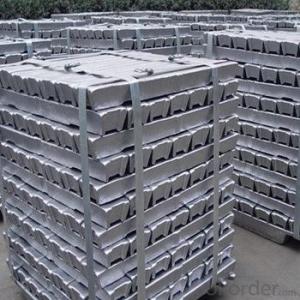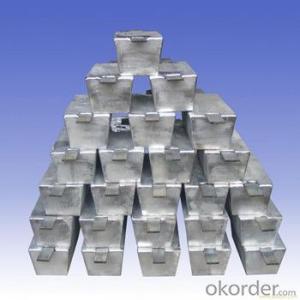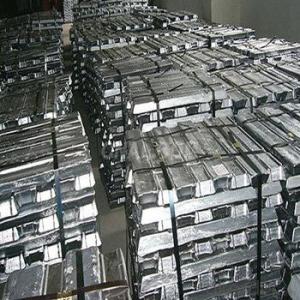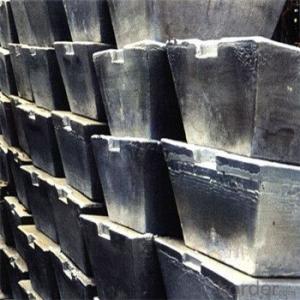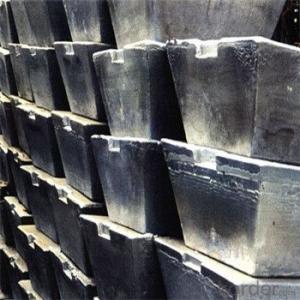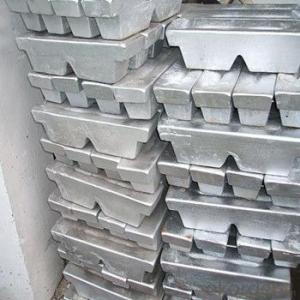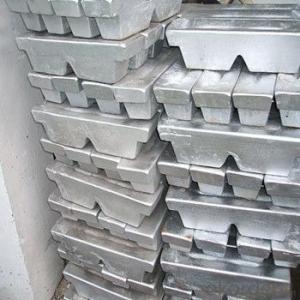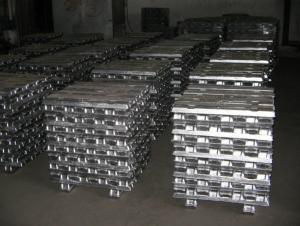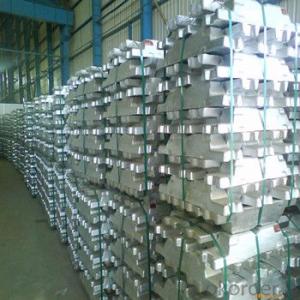Aluminium Ingot 99.97% for Choice with Top Quality
- Loading Port:
- China main port
- Payment Terms:
- TT OR LC
- Min Order Qty:
- 1000 m.t.
- Supply Capability:
- 10000 m.t./month
OKorder Service Pledge
OKorder Financial Service
You Might Also Like
Pure Aluminum Ingot Used for Industry
1.Structure of Aluminum Ingot Description
Aluminum Ingot is with the AL as the main chemical composition. Aluminum Ingot is used for industry,such as automobile,pinning and weaving,electron broadly and so on. Aluminum Ingot has the following advantages: easy control and operation, fast melting.
2.Main Features of the Aluminum Ingot
•High Purity
•Easy control and operation
•High strength
•Fast melting
•Competitive price
•Best Service
3. Aluminum Ingot Images

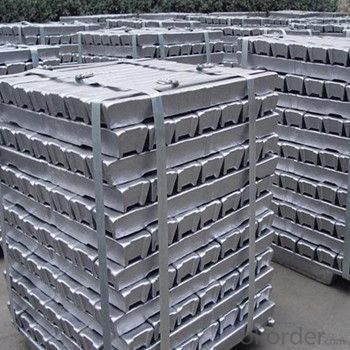
4. Aluminum Ingot Specification
Grade | Chemical Composition % | |||||||||
Al≥ | impurities ≤ | |||||||||
Si | Fe | Cu | Ga | Mg | Zn | Mn | others | Sum | ||
Al99.9 | 99.90 | 0.50 | 0.07 | 0.005 | 0.02 | 0.01 | 0.025 | - | 0.010 | 0.10 |
Al99.85 | 99.85 | 0.80 | 0.12 | 0.005 | 0.03 | 0.02 | 0.030 | - | 0.015 | 0.15 |
Al99.7 | 99.70 | 0.10 | 0.20 | 0.010 | 0.03 | 0.02 | 0.030 | - | 0.030 | 0.30 |
Al99.6 | 99.60 | 0.16 | 0.25 | 0.010 | 0.03 | 0.03 | 0.030 | - | 0.030 | 0.40 |
Al99.5 | 99.50 | 0.22 | 0.30 | 0.020 | 0.03 | 0.05 | 0.050 | - | 0.030 | 0.50 |
Al99.00 | 99.00 | 0.42 | 0.50 | 0.020 | 0.03 | 0.05 | 0.050 | - | 0.050 | 1.00 |
5.FAQ of Aluminum Ingot
We have organized several common questions for our clients,may help you sincerely:
①How about your company?
A world class manufacturer & supplier of castings forging in carbon steel and alloy steel,is one of the large-scale professional investment casting production bases in China,consisting of both casting foundry forging and machining factory. Annually more than 8000 tons Precision casting and forging parts are exported to markets in Europe,America and Japan. OEM casting and forging service available according to customer’s requirements.
②How to guarantee the quality of the products?
We have established the international advanced quality management system,every link from raw material to final product we have strict quality test;We resolutely put an end to unqualified products flowing into the market. At the same time, we will provide necessary follow-up service assurance.
③How long can we receive the product after purchase?
In the purchase of product within three working days, We will arrange the factory delivery as soon as possible. The pecific time of receiving is related to the state and position of customers.Commonly 7 to 10 working days can be served.
- Q:What is the difference between aluminium ingot YL112 and YLD112?
- The difference between YL112 and YLD112 is that of aluminium ingot:YLD102 is the main alloy element for die casting and forging. It is a silicon second aluminum alloy,
- Q:Lead and Feng Sheng aluminum profile which is better
- Al Feng can't be compared with Zhensheng aluminum, aluminum frame is false, but a little thick, thin inner frame is good, it is to deceive the people and consumers, but not resistant and durable, the outer protective layer can be seen without vibration or aluminum smooth and bright, if there is a recommendation of Al - Feng, hope that consumers do not believe
- Q:How are aluminum ingots used in the production of signage?
- The lightweight, durable, and versatile nature of aluminum ingots makes them crucial in the production of signage. When creating signage, aluminum ingots are melted and then turned into various sign components or sheets, depending on the desired design and purpose. One of the primary uses of aluminum ingots in signage production is for crafting sign frames. These frames provide structural support and stability to the signage, ensuring its longevity and resistance to weather conditions. Aluminum's lightweight nature makes it easier to transport, install, and maintain these sign frames. Furthermore, aluminum ingots are commonly utilized in creating sign panels or sheets. These panels can be cut, drilled, or shaped into different sizes and designs, allowing for customization and creativity in signage production. The durability of aluminum guarantees that these panels can endure outdoor exposure and remain intact for long periods. Moreover, aluminum ingots are employed in producing sign letters or logos. Signage made from aluminum letters provides a professional and sleek appearance that can enhance the overall aesthetic appeal of the signage. By using aluminum ingots, sign manufacturers can effortlessly create precise and intricate lettering. Additionally, aluminum ingots offer excellent corrosion resistance, making them ideal for outdoor signage applications. They can withstand harsh weather conditions, UV exposure, and temperature variations without deteriorating or losing their visual appeal. This makes aluminum an optimal material for outdoor signs where durability and longevity are crucial. In conclusion, the lightweight, durable, and versatile nature of aluminum ingots makes them widely used in signage production. They are transformed into sign frames, panels, and letters, providing structural support, customization options, and a professional appearance. With their corrosion resistance, aluminum ingots ensure that signage remains intact and visually appealing even in challenging outdoor environments.
- Q:How are aluminum ingots used in the production of electronic devices?
- Aluminum ingots are primarily used in the production of electronic devices as a material for creating casings and housings. The ingots are melted and shaped into desired forms, providing a lightweight yet durable structure for electronic devices such as smartphones, laptops, and tablets. Aluminum's excellent thermal conductivity also helps in dissipating heat generated by electronic components, ensuring optimal performance and preventing overheating issues. Additionally, the corrosion-resistant properties of aluminum make it a popular choice for protecting electronic circuits from external elements.
- Q:How is aluminium ingot made?
- Aluminium is a silvery white metal, second only to oxygen and silicon in the earth's crust, and ranks third. The density of aluminum is smaller than that of aluminum ingots, only 34.61% of iron and 30.33% of copper, so it is also called light metal.
- Q:102 non-standard aluminum ingot is like? And ordinary non-standard aluminum ingot what is the difference?
- 102 refers to ZLD102 bar, since there are grades, that is, GB aluminum ingots. Non-standard 102 may also refer to the main elements in the scope of the impurities exceeded the standard aluminum ingot, non-standard name.
- Q:How are aluminum ingots used in the production of consumer goods?
- Due to their versatility and desirable properties, aluminum ingots have become widely used in the manufacturing of consumer goods. These ingots undergo a process of melting and transformation into different forms, such as sheets, bars, or coils, to suit various manufacturing processes. One popular application of aluminum ingots is in the production of packaging materials. Aluminum foils and cans, which are lightweight, corrosion-resistant, and malleable, are ideal for preserving food and beverages. The ingots are rolled into thin sheets, which are then used to create these packaging materials. The automotive industry is another major user of aluminum ingots. Aluminum's low density and high strength-to-weight ratio make it an excellent choice for manufacturing car parts, including engine components, body panels, and wheels. By utilizing aluminum ingots, automakers can produce lighter vehicles, leading to improved fuel efficiency and better performance. Moreover, aluminum ingots find extensive usage in the construction sector. These ingots are often extruded into profiles used for windows, doors, and curtain walls. Aluminum's corrosion resistance and ability to withstand extreme weather conditions make it a popular choice for building materials. Furthermore, aluminum ingots are employed in the production of consumer electronics. The lightweight characteristics of aluminum make it an ideal material for manufacturing laptops, tablets, and smartphones, where weight reduction is crucial for portability. The ingots are processed into casings, frames, and other components for these electronic devices. In summary, aluminum ingots play a crucial role in manufacturing a wide range of consumer goods. Their versatility, lightweight nature, and corrosion resistance make them suitable for various applications in industries such as packaging, automotive, construction, and electronics.
- Q:What is the impact of alloying elements on the properties of aluminum ingots?
- The properties of aluminum ingots are significantly influenced by alloying elements. These elements are incorporated into aluminum during the alloying process to enhance its mechanical, physical, and chemical properties. One of the primary effects of alloying elements is the enhancement of strength and hardness. For example, copper, manganese, and zinc additions can increase the strength of aluminum, making it suitable for applications that require high structural integrity. Conversely, the addition of magnesium can improve both the strength and hardness of aluminum, making it ideal for structural components in industries like aerospace and automotive. Alloying elements also play a crucial role in improving the corrosion resistance of aluminum. Chromium, copper, and silicon elements create a protective oxide layer on the aluminum's surface, preventing corrosion in harsh environments. By adding these elements, the lifespan of aluminum ingots is increased, making them more durable and reliable in various applications. Moreover, alloying elements can have an impact on the thermal conductivity and electrical conductivity of aluminum. Copper and silicon elements enhance both thermal and electrical conductivity, making aluminum alloys suitable for heat exchangers, electrical conductors, and electronic components. Additionally, alloying elements can influence the casting and machining characteristics of aluminum ingots. Elements like silicon and magnesium improve fluidity during casting, reducing defects and enhancing the overall quality of the final product. Moreover, the presence of certain elements can affect the machinability of aluminum, making shaping and processing easier or more challenging. Overall, alloying elements have a profound impact on the properties of aluminum ingots. They enhance strength, hardness, corrosion resistance, thermal and electrical conductivity, and influence casting and machining characteristics. Therefore, the careful choice and composition of alloying elements are crucial in determining the suitability of aluminum ingots for specific applications.
- Q:How are aluminum ingots used in the production of kitchen utensils?
- Aluminum ingots are used in the production of kitchen utensils due to their unique properties and advantages. Firstly, aluminum is a lightweight metal that is easy to handle, making it ideal for manufacturing utensils that are comfortable to use. Additionally, aluminum has excellent heat conductivity, allowing for quick and even heat distribution when cooking. This property is especially important for pots, pans, and other cookware, as it ensures that food is cooked evenly and efficiently. Moreover, aluminum is highly resistant to corrosion and rust, making it a durable material for kitchen utensils. This feature is crucial, as kitchen utensils are often exposed to water, heat, and various chemicals during cooking and cleaning. Furthermore, aluminum is a non-reactive metal, meaning it does not react with acidic or alkaline foods. This makes it safe to use for all types of cooking, including those involving acidic ingredients like tomatoes or citrus fruits. To produce kitchen utensils, aluminum ingots are melted down and cast into the desired shapes using molds. The ingots are heated to their melting point and then poured into the molds, where they solidify and take the form of the utensil. Afterward, the utensils are polished, coated, or anodized to enhance their appearance, durability, and non-stick properties. In conclusion, aluminum ingots are extensively utilized in the production of kitchen utensils because of their lightweight nature, excellent heat conductivity, corrosion resistance, non-reactivity, and durability. These properties make aluminum an ideal material for creating a wide range of cookware that is efficient, safe, and long-lasting.
- Q:Can aluminum ingots be anodized?
- Aluminum ingots are capable of undergoing anodization. Anodization, an electrochemical procedure, yields a safeguarding oxide layer on the exterior of aluminum. This technique can be employed on aluminum ingots, sheets, or any other manifestations. Anodization boasts numerous advantages, including heightened resistance against corrosion, enhanced durability, and the potential to introduce color onto the surface. Moreover, the anodized layer enriches the aesthetic appeal of the aluminum and facilitates superior adhesion of paints or dyes. In summary, the anodization of aluminum ingots is a prevalent practice across diverse industries to augment both the properties and appearance of the metal.
1. Manufacturer Overview |
|
|---|---|
| Location | |
| Year Established | |
| Annual Output Value | |
| Main Markets | |
| Company Certifications | |
2. Manufacturer Certificates |
|
|---|---|
| a) Certification Name | |
| Range | |
| Reference | |
| Validity Period | |
3. Manufacturer Capability |
|
|---|---|
| a)Trade Capacity | |
| Nearest Port | |
| Export Percentage | |
| No.of Employees in Trade Department | |
| Language Spoken: | |
| b)Factory Information | |
| Factory Size: | |
| No. of Production Lines | |
| Contract Manufacturing | |
| Product Price Range | |
Send your message to us
Aluminium Ingot 99.97% for Choice with Top Quality
- Loading Port:
- China main port
- Payment Terms:
- TT OR LC
- Min Order Qty:
- 1000 m.t.
- Supply Capability:
- 10000 m.t./month
OKorder Service Pledge
OKorder Financial Service
Similar products
New products
Hot products
